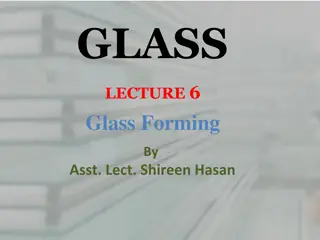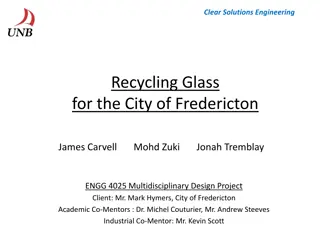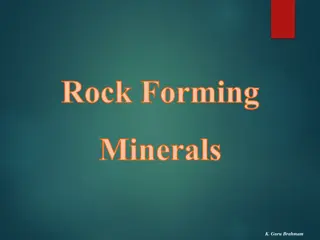Carbonates Replacing Plagioclase Glass in Martian Meteorite ALH84001
The carbonates replacing plagioclase glass in the Martian meteorite ALH84001 have raised questions about their origin - whether they are biologically formed or through other geological processes. Discovered in Antarctica in 1984, this meteorite has been dated to over 4 billion years and initially misclassified as a diogenite. Intensive shock deformation and fluid infiltration are evident, with possibilities of biological involvement, low-temperature fluid cementation, impact melt solidification, or non-biological glass replacement. Detailed imaging and analysis suggest that the carbonate formation involved pre-existing weaknesses in the glass structure. Ongoing research continues to explore the implications of these findings for understanding Mars' geological history.
Download Presentation

Please find below an Image/Link to download the presentation.
The content on the website is provided AS IS for your information and personal use only. It may not be sold, licensed, or shared on other websites without obtaining consent from the author.If you encounter any issues during the download, it is possible that the publisher has removed the file from their server.
You are allowed to download the files provided on this website for personal or commercial use, subject to the condition that they are used lawfully. All files are the property of their respective owners.
The content on the website is provided AS IS for your information and personal use only. It may not be sold, licensed, or shared on other websites without obtaining consent from the author.
E N D
Presentation Transcript
Carbonates replacing plagioclase glass in the Martian meteorite ALH84001 A. Macartney1, T. Tomkinson1, E.R.D. Scott2, M.R. Lee1, 1School of Geographical and Earth Sciences, University of Glasgow, UK, Email: a.macartney.1@research.gla.ac.uk 2Hawai i Institute of Geophysics and Planetology, USA. =O C Carbonate: CO2 + H2O = CO3-2 + Mg2+ Ca2+ etc. Creates (CaMg)(CO3)2 O- -O Martian implications? On Earth they form either by fluid deposition or biological activity Both offer insight to Mars history But are the carbonates in ALH 84001 biological?
Discovered in Alan Hills, Antarctica, 1984 weighing 1.93 kg Dated at 4.091 0.030 billion years Misclassified as a diogenite until 1994 McKay et al. 1996 proposed fossil bacteria in the carbonates ALH 84001 173 The most controversial piece of Mars?
Intensive multiple shock deformation. Fluid and glass ingress
Clusters of pore space from remnant grains now filled with feldspathic glass and carbonate surrounded by orthopyroxene grains
Overview of carbonate formation possibilities 1.) Biological with associated fossil or shell evidence unrelated to glass 2.) Cementation and occlusion in pores from low temperature allochthonous fluids unrelated to glass 3.) Solidification contemporaneous with impact melt glass at high temperature non-biological and unconducive to life 4.) Replacement of glass at low temperatures (~150 C) non-biological but potentially conducive to life
Oscar Wilde on geology: If you re going to FIB, better to make it provocatively interesting and varied, with the potential to incite at least a little scandal FIB: Focussed Ion Beam
Transmission Electron Microscope (TEM) imaging and Bragg diffraction identification 200 nm Carbonate Orthopyroxene Glass Interpretation: Carbonates cross cuts and replaces glass via lines of pre-existing weakness
Scanning Electron Microscope (SEM) X-ray mapping highlight Ca-Mg-Fe carbonate zonation
Cause of carbonate zonation? Depleting water to rock ratio (W:R) or Drop in system pressure Causes cation density to increase
Feldspathic glass-carbonate interface characterized by pore space depressions interpreted as former cation rich fluid pools. Glass releases cations into the fluid pool and carbonates precipitate out.
Generational sequences Unreacted glass . Lack of fluid in the system?
Summary of multiple generation carbonate sequences 2.) 1.) Pre-existing carbonate Structures and glass Impact crack. Intrusion by melt glass and fluid 3.) 4.) Second generation carbonates form due to glass-fluid interaction Glass is fully replaced by carbonate if enough fluid is available
Conclusions Multiple shock history of ALH84001 Carbonate zoning due to W:R changes or pressure drops Impact melt glass abiotically replaced by carbonate only when fluid available No evidence for little aliens in ALH 84001 but a beautifully complex history of overlapping, chemically distinct, generations of glass and zoned carbonates
Astrobiology Workshop 2015 'Building Habitable Worlds' 25th February 2015 Venue: Glasgow Science Centre Free Registration Website: http://www.astrobiology2015.moonfruit.com/























